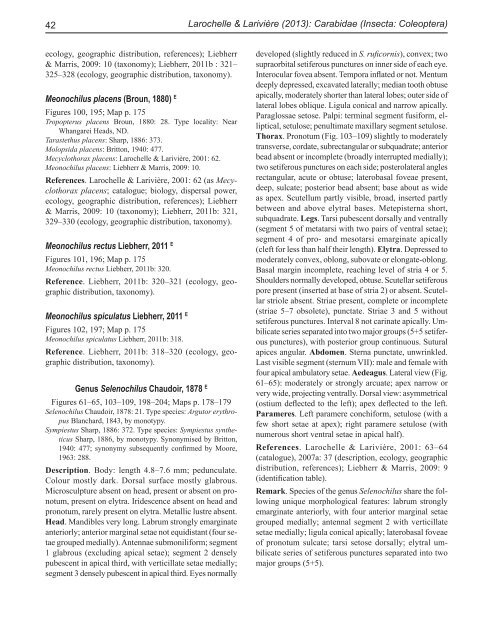Fauna of New Zealand 69 - Landcare Research
Fauna of New Zealand 69 - Landcare Research
Fauna of New Zealand 69 - Landcare Research
Create successful ePaper yourself
Turn your PDF publications into a flip-book with our unique Google optimized e-Paper software.
42<br />
ecology, geographic distribution, references); Liebherr<br />
& Marris, 2009: 10 (taxonomy); Liebherr, 2011b : 321–<br />
325–328 (ecology, geographic distribution, taxonomy).<br />
Meonochilus placens (Broun, 1880) E<br />
Figures 100, 195; Map p. 175<br />
Tropopterus placens Broun, 1880: 28. Type locality: Near<br />
Whangarei Heads, ND.<br />
Tarastethus placens: Sharp, 1886: 373.<br />
Molopsida placens: Britton, 1940: 477.<br />
Mecyclothorax placens: Larochelle & Larivière, 2001: 62.<br />
Meonochilus placens: Liebherr & Marris, 2009: 10.<br />
References. Larochelle & Larivière, 2001: 62 (as Mecyclothorax<br />
placens; catalogue; biology, dispersal power,<br />
ecology, geographic distribution, references); Liebherr<br />
& Marris, 2009: 10 (taxonomy); Liebherr, 2011b: 321,<br />
329–330 (ecology, geographic distribution, taxonomy).<br />
Meonochilus rectus Liebherr, 2011 E<br />
Figures 101, 196; Map p. 175<br />
Meonochilus rectus Liebherr, 2011b: 320.<br />
Reference. Liebherr, 2011b: 320–321 (ecology, geographic<br />
distribution, taxonomy).<br />
Meonochilus spiculatus Liebherr, 2011 E<br />
Figures 102, 197; Map p. 175<br />
Meonochilus spiculatus Liebherr, 2011b: 318.<br />
Reference. Liebherr, 2011b: 318–320 (ecology, geographic<br />
distribution, taxonomy).<br />
Genus Selenochilus Chaudoir, 1878 E<br />
Figures 61–65, 103–109, 198–204; Maps p. 178–179<br />
Selenochilus Chaudoir, 1878: 21. Type species: Argutor erythropus<br />
Blanchard, 1843, by monotypy.<br />
Sympiestus Sharp, 1886: 372. Type species: Sympiestus syntheticus<br />
Sharp, 1886, by monotypy. Synonymised by Britton,<br />
1940: 477; synonymy subsequently confirmed by Moore,<br />
1963: 288.<br />
Description. Body: length 4.8–7.6 mm; pedunculate.<br />
Colour mostly dark. Dorsal surface mostly glabrous.<br />
Microsculpture absent on head, present or absent on pronotum,<br />
present on elytra. Iridescence absent on head and<br />
pronotum, rarely present on elytra. Metallic lustre absent.<br />
Head. Mandibles very long. Labrum strongly emarginate<br />
anteriorly; anterior marginal setae not equidistant (four setae<br />
grouped medially). Antennae submoniliform; segment<br />
1 glabrous (excluding apical setae); segment 2 densely<br />
pubescent in apical third, with verticillate setae medially;<br />
segment 3 densely pubescent in apical third. Eyes normally<br />
Larochelle & Larivière (2013): Carabidae (Insecta: Coleoptera)<br />
developed (slightly reduced in S. ruficornis), convex; two<br />
supraorbital setiferous punctures on inner side <strong>of</strong> each eye.<br />
Interocular fovea absent. Tempora inflated or not. Mentum<br />
deeply depressed, excavated laterally; median tooth obtuse<br />
apically, moderately shorter than lateral lobes; outer side <strong>of</strong><br />
lateral lobes oblique. Ligula conical and narrow apically.<br />
Paraglossae setose. Palpi: terminal segment fusiform, elliptical,<br />
setulose; penultimate maxillary segment setulose.<br />
Thorax. Pronotum (Fig. 103–109) slightly to moderately<br />
transverse, cordate, subrectangular or subquadrate; anterior<br />
bead absent or incomplete (broadly interrupted medially);<br />
two setiferous punctures on each side; posterolateral angles<br />
rectangular, acute or obtuse; laterobasal foveae present,<br />
deep, sulcate; posterior bead absent; base about as wide<br />
as apex. Scutellum partly visible, broad, inserted partly<br />
between and above elytral bases. Metepisterna short,<br />
subquadrate. Legs. Tarsi pubescent dorsally and ventrally<br />
(segment 5 <strong>of</strong> metatarsi with two pairs <strong>of</strong> ventral setae);<br />
segment 4 <strong>of</strong> pro- and mesotarsi emarginate apically<br />
(cleft for less than half their length). Elytra. Depressed to<br />
moderately convex, oblong, subovate or elongate-oblong.<br />
Basal margin incomplete, reaching level <strong>of</strong> stria 4 or 5.<br />
Shoulders normally developed, obtuse. Scutellar setiferous<br />
pore present (inserted at base <strong>of</strong> stria 2) or absent. Scutellar<br />
striole absent. Striae present, complete or incomplete<br />
(striae 5–7 obsolete), punctate. Striae 3 and 5 without<br />
setiferous punctures. Interval 8 not carinate apically. Umbilicate<br />
series separated into two major groups (5+5 setiferous<br />
punctures), with posterior group continuous. Sutural<br />
apices angular. Abdomen. Sterna punctate, unwrinkled.<br />
Last visible segment (sternum VII): male and female with<br />
four apical ambulatory setae. Aedeagus. Lateral view (Fig.<br />
61–65): moderately or strongly arcuate; apex narrow or<br />
very wide, projecting ventrally. Dorsal view: asymmetrical<br />
(ostium deflected to the left); apex deflected to the left.<br />
Parameres. Left paramere conchiform, setulose (with a<br />
few short setae at apex); right paramere setulose (with<br />
numerous short ventral setae in apical half).<br />
References. Larochelle & Larivière, 2001: 63–64<br />
(catalogue), 2007a: 37 (description, ecology, geographic<br />
distribution, references); Liebherr & Marris, 2009: 9<br />
(identification table).<br />
Remark. Species <strong>of</strong> the genus Selenochilus share the following<br />
unique morphological features: labrum strongly<br />
emarginate anteriorly, with four anterior marginal setae<br />
grouped medially; antennal segment 2 with verticillate<br />
setae medially; ligula conical apically; laterobasal foveae<br />
<strong>of</strong> pronotum sulcate; tarsi setose dorsally; elytral umbilicate<br />
series <strong>of</strong> setiferous punctures separated into two<br />
major groups (5+5).
















